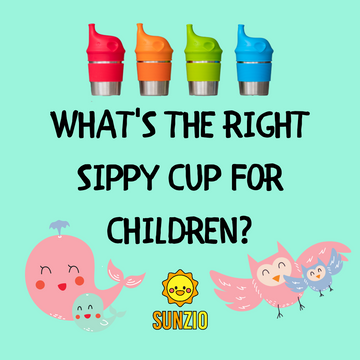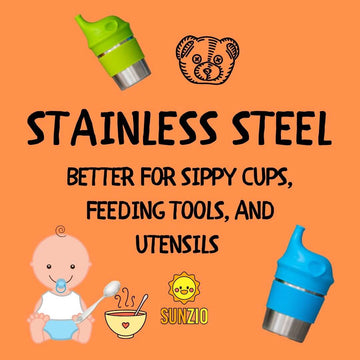
If your child has now finished breastfeeding or is ready to move on from the bottle, then it is time to find the right sippy cup. Many parents choose to use sippy cups when their child reaches toddler age. They are good at preventing spills and can be easily carried wherever you go.
There are many choices when it comes to sippy cups. We believe the first thing to decide is to find a non-plastic cup and go for one made of stainless steel. Check out our blog post about why we recommend stainless steel over plastic.
From breast or bottle, it can be hard for your child to transition to sippy cups since it will be another adjustment for them. Sometimes, they simply don’t like the feel of the new cup in their mouth. A sippy cup that with a flexible silicone lid can make it easier for kids to transition from the breast or bottle.
Plastic vs Stainless Steel Sippy Cups: Which Is the Right Sippy Cup for Your Child?
Plastic Sippy Cups: The Downside
1. Contains Chemicals
Plastic, as discussed in our previous blog, leaches chemicals into food and drinks, which makes it dangerous to be used by children. It is best to stay away from plastic when it comes to your child’s feeding products.
*Click here to learn more: https://www.sunzioweb.com/stainless-steel-a-much-better-material-than-plastic-for-feeding-your-children/
2. Affects Speech Development
Aside from the toxic chemicals that could leach into the drinks, it can also affect the child’s speech development. According to Speech Language Pathologists (SLPs) from Pediatric Boulevard:
“The development of a more mature sucking pattern is vital in overall tongue positioning. Traditional (hard plastic) sippy cups can encourage the tongue to sit more forward in the mouth.
Similar to what happens with thumb suckers, the development of a more forward tongue positioning can affect dentition AND speech development, most commonly seen as a frontal or lateral lisp. For younger children, they may have issues with tongue tip elevation (lifting the tip of the tongue) due to constant posturing of the tongue tip being held down while suckling from a traditional sippy cup. Difficulty with tongue tip elevation affects the ability to make the /t,d,l,n/ sounds appropriately.
In addition, when the tongue tip can’t elevate (lift up by itself) it can also affect how your child properly swallows their food or saliva. When toddlers continue to use the infant swallow pattern, it can affect their ability to chew and swallow effectively which could make trying new foods more challenging”.
Who knew that the position and movement of a child’s tongue and how they drink from a sippy cup could be such a major factor in their speech development? As parents, we look at sippy cups as a great way to lessen spills and transition away from bottles – that is true – but we also need to be aware of choosing the right sippy cup that won’t harm their development in any way.
3. Change Oral Cavity Development
Continuous sipping on a hard spout can change the oral cavity development of a child. Breast and bottle nipples are soft and can change shape when a child sucks on it, but traditional sippy cups don’t, which causes their mouth to develop improperly.
According to Dr. Mark Burhenne, “It takes a different shape inside the mouth of the child and helps promote proper development of all the oral structures, including the jawbone, palate, teeth, and oral cavity. It helps the child learn the proper motor function of the tongue.”
Advantages of Stainless Sippy Cups with Silicone Lids
1. Silicone Spout Mimics the Nipple
We designed a soft silicone spout on our sippy cups that mimics a mother’s or baby bottle’s nipple. This makes it easy for a child to drink from the cup. The silicone lids are also removable so that when your child is ready to move on from the sippy lid, they can continue drinking from the same cup. Soft spouts made of a material like silicone can also lessen accidents around the lips and mouth.
2. Easy Transitioning from Bottle or Breast
To Sippy cups then to Open Cups
Most pediatricians advise weaning your baby from the bottle (formula) at 12 months old and switching to a cup. Sippy cups are an excellent choice for helping your child make this transition, but be sure that it has a soft lid.
Soft lids made of a material like silicone will help your child adjust easily and allow you to say bye-bye to his or her bottle. You can also switch between a sippy cup and an open cup from time to time. This will help foster and support oral motor skill development as mentioned above. It will also allow their face muscles, tongue, and soft palate to be trained.
3. Use It for the Long Haul
Sippy cups should be used until around age 3. At this point, children have developed their fine motor skills, and they can grip cups properly. You should be able to train them to be able to drink out of a normal cup.
This is what makes SunZio sippy cups even more special – when your child is ready to move on from the sippy cup, you can simply stop attaching the silicone lid and allow them to continue using the stainless steel cup. There’s no need to buy another cup. Plus, our cups also have rounded edges, making them safe and comfortable for drinking.
Keep a Lookout!
Tooth Decay
You also need to be careful when filling your child’s training cup with sweet drinks, such as fruit juices or soda. Frequent sipping or sucking on plastic sippy cups with sugary drinks can leave sugars and acids on your child’s teeth, increasing their chances of developing tooth decay. Sugar can erode the enamel on the teeth, leading to dental problems.
Mold
Stainless steel is it isn’t a conducive environment for mold development because mold spores thrive on porous surfaces. There’s still a chance for other microorganisms like bacteria to grow, so you need to clean and sterilize the sippy cups after every use. Silicones are no exception. Mold grows where there is moisture, so you need not only clean the cups but dry them thoroughly afterwards.
If you don’t thoroughly clean your sippy cups after each use, mold growth can cause illness or other symptoms in your child. We’ve made a checklist at the bottom, so you can make sure it’s clean and safe!
Minimizing Safety Risks and Keeping Your Cups Clean
Here are some care and usage tips for you to keep in mind:
- Always clean the cups properly – wash all parts with soap and hot water (they’re easy to clean and dishwasher-safe)
- Keep molds away by cleaning them thoroughly
- Always take off the lids (disassembling the sippy cup) and make sure they’re completely dry before storing
- Rinsing your child’s sippy cup immediately after use.
- Sterilizing in hot water for 15 minutes to loosen any dried food or milk.
Now that you know that difference between plastic vs stainless steel sippy cups, you can choose the right sippy cup for your child. Stainless steel sippy cups are undoubtedly the winner in this comparison. Although you’ll pay a bit extra for stainless steel sippy cups, the safety of your child is all the more worth it!
Sources:




